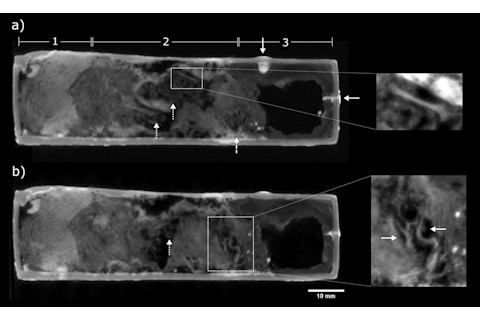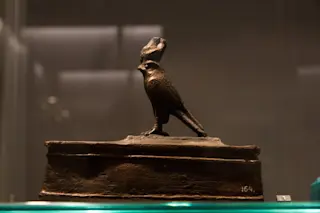For the first archaeologists, the only way to peer inside an ancient coffin or container was to take the artifact apart. In fact, it was only through the dismantling of ancient artifacts that these individuals learned about the lives, religions and rituals of antiquity, including those of Egypt.
Nowadays, there's a longer list of less invasive approaches for learning about antiquity, and that list is expanding. According to a paper published in Scientific Reports, for instance, a team of researchers recently applied a new, non-invasive imaging technique to six sealed coffins from around 2,500 years ago in Egypt.
Revealing the remains of mummified lizards, the team says that the paper provides a clearer picture of the process of ancient animal preservation while also signaling the suitability of the new technique for future investigations of ancient artifacts.
A Closer Look at Mummified Animals
Animal mummification was widely practiced in Ancient Egypt as a way to gain the favor of the gods, many of whom were associated with animals such as cats, crocodiles and serpents. And while many of these mummified animals were sealed inside animal-shaped statues and statuettes, many others were sealed inside small coffins made out of cast metal.
Since the 1970s, when archaeologists applied computed tomography (CT) to mummies for the first time, researchers have harnessed the technique to take a closer look at these ancient animal mummies — however they were held — without risking any harm to the artifacts themselves. The scans that result are sometimes so clear that they can reveal the tiniest fragments of the mummies' fine fabric wrappings.

(Credit: Daniel O’Flynn, Anna Fedrigo, Laura Perucchetti, and Aurélia Masson-Berghoff/Scientific Reports).Applying a technique known as neutron tomography, the researchers revealed that the ancient coffins contained a combination of animal remains and fragments of fabric wrappings.
Daniel O’Flynn, Anna Fedrigo, Laura Perucchetti, and Aurélia Masson-Berghoff/Scientific Reports
But while computed tomography has been very successful in revealing animal mummies placed inside statues and statuettes, it hasn’t been very successful in revealing animal mummies placed inside metal coffins. That's because the presence of metal can sometimes create streaks or shadows, also known as “artifacts,” in CT scans, concealing the true appearance of the contents of the containers.
Selecting six sealed coffins from the collections of the British Museum that had been unsuccessfully scanned with CT in the past and analyzing them using an alternative technique of neutron tomography, researchers found that three coffins contained the remains of ancient animals — likely lizards — and fabric fragments.
Read More: The Animal Mummy Business
A New Approach to Ancient Animal Mummies
Building a three-dimensional image of an artifact based on its ability to absorb neutrons, neutron tomography scanners shoot a beam of neutrons toward an artifact and use the patterns of absorption to reconstruct the artifact's shape and structure, according to a press release about the research.
Sending these beams of neutrons toward the six coffins, the researchers revealed bones and bone fragments, including an intact lizard skull, in three of the six containers. They also found fabric fragments in the same three coffins, potentially made of linen, which was the Egyptian’s favorite material for wrapping their mummies. According to the researchers, the fabric was wrapped around the lizards — in all likelihood — before they were sealed inside.
The trimmings of the coffins also support the theory that several of the containers featured the corpses of ancient lizards. All six of the coffins, which were cast from compounds of copper, were adorned with three-dimensional depictions of lizards, snakes and eels, some of which featured human heads.
While three of the coffins came from the ancient city of Naukratis, one came from Tell el-Yehudiyeh, and two came from unknown locations. They all originated in the first millennium B.C., however, between the years 660 and 250.
“The findings demonstrate the effectiveness of neutron tomography for the study of mummified remains inside sealed metal containers,” the researchers state in their paper, “and give evidence linking the animal figures represented on top of [the containers] to the concealed remains.”
Read More: This Tomb Contains 10 Mummified Crocodiles From 2,500 Years Ago















